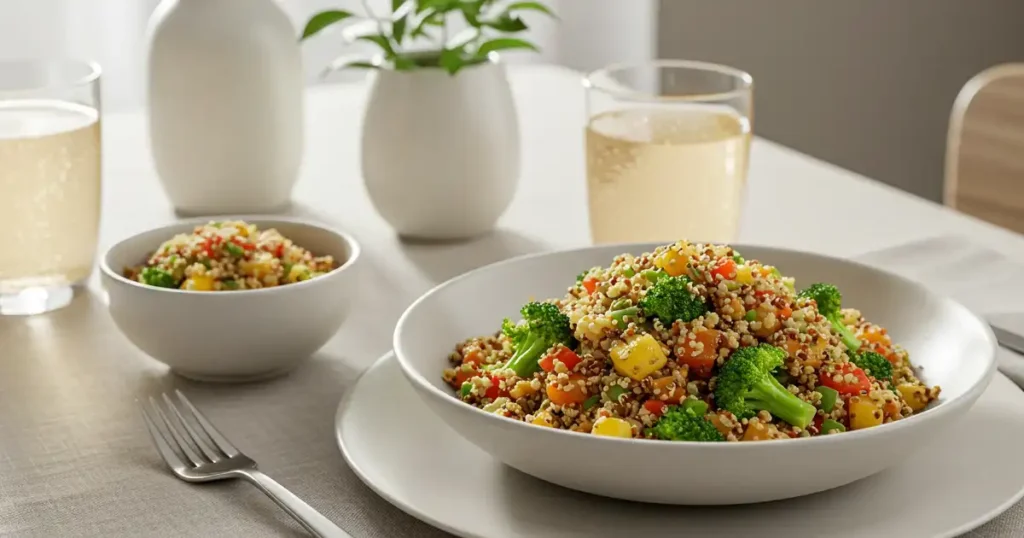
Table of Contents
Fried rice is a delicious, versatile, and easy-to-make dish that can be customized to suit various dietary preferences. However, traditional fried rice recipes can be high in calories, sodium, and unhealthy fats. That’s why we’ve put together five nutritious and flavorful fried rice recipes that are both healthy and satisfying. These recipes are packed with nutrient-rich ingredients, fiber, and protein, making them a perfect addition to a balanced diet.
1. Quinoa Fried Rice with Vegetables
Quinoa is an excellent alternative to white rice because it is high in protein, fiber, and essential amino acids. This quinoa fried rice is loaded with fresh vegetables and provides a delicious, healthy twist on the classic dish.
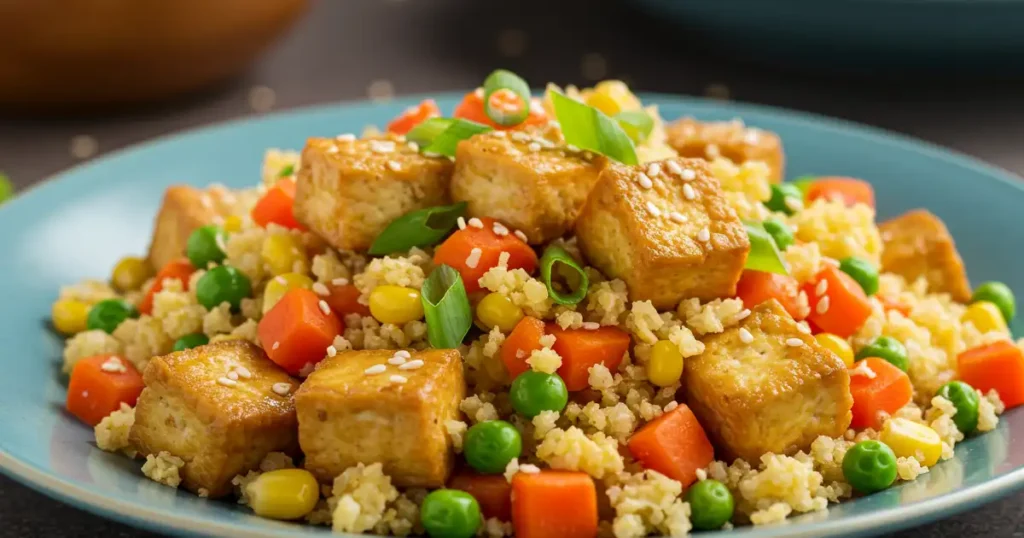
Ingredients:
- 1 cup cooked quinoa
- 1 tablespoon olive oil
- ½ cup diced carrots
- ½ cup green peas
- ½ cup diced bell peppers
- 1 clove garlic, minced
- ½ teaspoon ginger, grated
- 2 tablespoons low-sodium soy sauce
- 1 egg, lightly beaten
- 1 green onion, chopped
- ½ teaspoon sesame seeds (optional)
Instructions:
- Heat olive oil in a large pan over medium heat.
- Add garlic and ginger, sauté for 30 seconds.
- Add diced carrots, peas, and bell peppers. Cook for 3-4 minutes until slightly tender.
- Stir in the cooked quinoa and soy sauce. Mix well.
- Push the mixture to one side of the pan and pour the beaten egg on the empty side. Scramble the egg and then mix it into the quinoa.
- Garnish with chopped green onions and sesame seeds before serving.
2. Cauliflower Fried Rice with Tofu
Cauliflower rice is a low-carb, grain-free alternative to traditional rice, making this dish perfect for those on ketogenic or paleo diets. With the addition of tofu, this recipe is also high in plant-based protein.
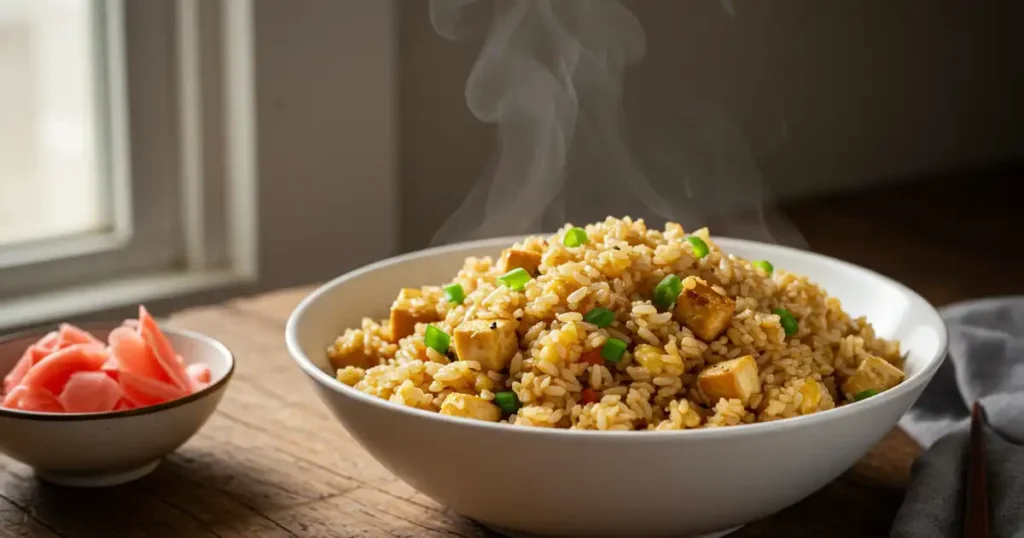
Ingredients:
- 2 cups riced cauliflower
- ½ cup diced tofu (firm or extra firm)
- 1 tablespoon sesame oil
- ½ cup chopped broccoli
- ½ cup shredded carrots
- ½ teaspoon garlic powder
- 2 tablespoons coconut aminos or low-sodium soy sauce
- 1 teaspoon rice vinegar
- ½ teaspoon black pepper
- 1 tablespoon green onions for garnish
Instructions:
- Heat sesame oil in a pan over medium-high heat.
- Add tofu and cook until golden brown on all sides. Remove and set aside.
- In the same pan, sauté the broccoli and carrots for 2-3 minutes.
- Add the riced cauliflower, garlic powder, soy sauce, rice vinegar, and black pepper. Stir well.
- Mix in the cooked tofu and cook for another 2 minutes.
- Garnish with green onions and serve immediately.
3. Brown Rice Fried Rice with Shrimp
Brown rice is a whole grain packed with fiber, vitamins, and minerals, making it a healthier alternative to white rice. This version with shrimp is rich in lean protein and omega-3 fatty acids.
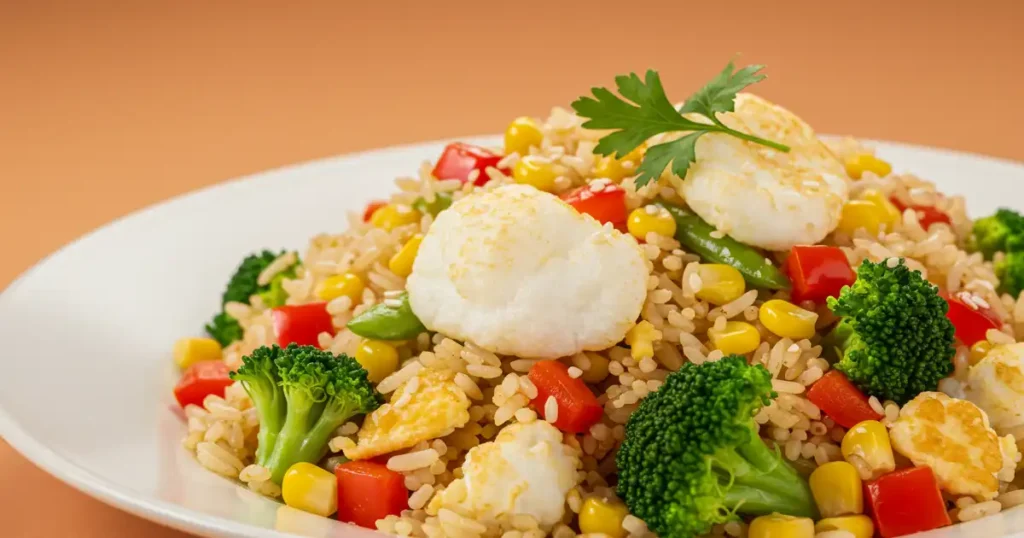
Ingredients:
- 1 cup cooked brown rice
- ½ cup shrimp, peeled and deveined
- 1 tablespoon avocado oil
- ½ cup diced zucchini
- ½ cup diced red bell pepper
- 1 clove garlic, minced
- 1 tablespoon low-sodium soy sauce
- ½ teaspoon smoked paprika
- 1 egg, scrambled
- ½ teaspoon sesame oil
- 1 teaspoon lime juice
Instructions:
- Heat avocado oil in a large skillet over medium-high heat.
- Add shrimp and cook for 2-3 minutes until pink. Remove and set aside.
- In the same pan, add zucchini, bell pepper, and garlic. Sauté for 3 minutes.
- Add the cooked brown rice, soy sauce, and smoked paprika. Stir well.
- Push the rice to one side and scramble the egg on the other side of the pan.
- Mix everything together, add the cooked shrimp, drizzle with sesame oil and lime juice, and serve hot.
4. High-Protein Egg White Fried Rice
For those looking for a high-protein, low-fat meal, this egg white fried rice is the perfect option. Using only egg whites reduces fat content while still providing plenty of protein and essential nutrients.
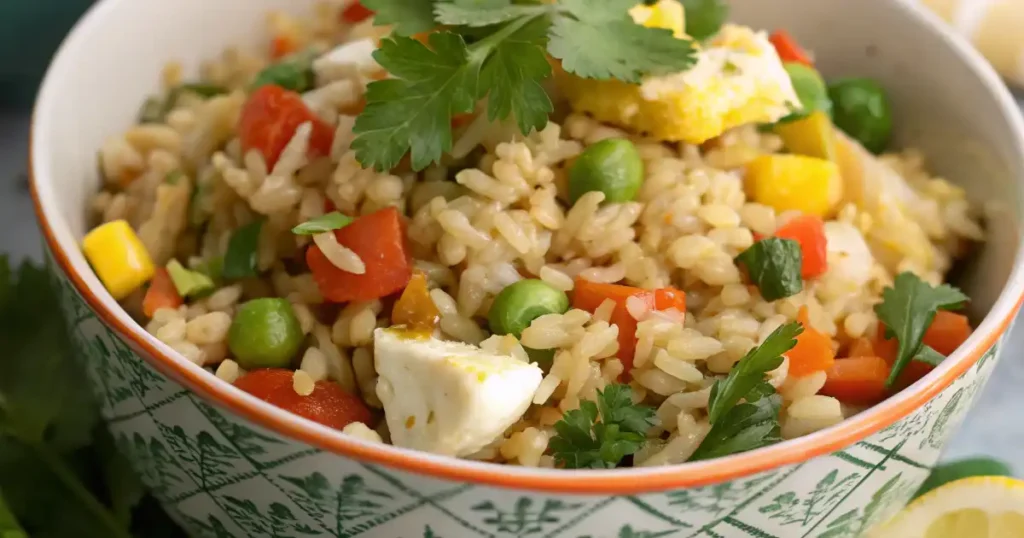
Ingredients:
- 1 cup cooked jasmine rice
- ½ cup egg whites
- 1 tablespoon olive oil
- ½ cup diced mushrooms
- ½ cup spinach
- ½ teaspoon turmeric
- 1 tablespoon low-sodium soy sauce
- 1 teaspoon sriracha (optional)
- ½ teaspoon sesame seeds
Instructions:
- Heat olive oil in a skillet over medium heat.
- Add mushrooms and sauté until soft, about 3 minutes.
- Stir in the spinach and cook for another 2 minutes.
- Add the cooked rice, turmeric, and soy sauce. Stir well.
- Pour in the egg whites and scramble them into the rice mixture.
- Serve hot with sesame seeds and sriracha for extra flavor.
5. Mediterranean Chickpea Fried Rice
This unique take on fried rice includes protein-rich chickpeas and Mediterranean flavors, making it a perfect meatless meal packed with nutrients.
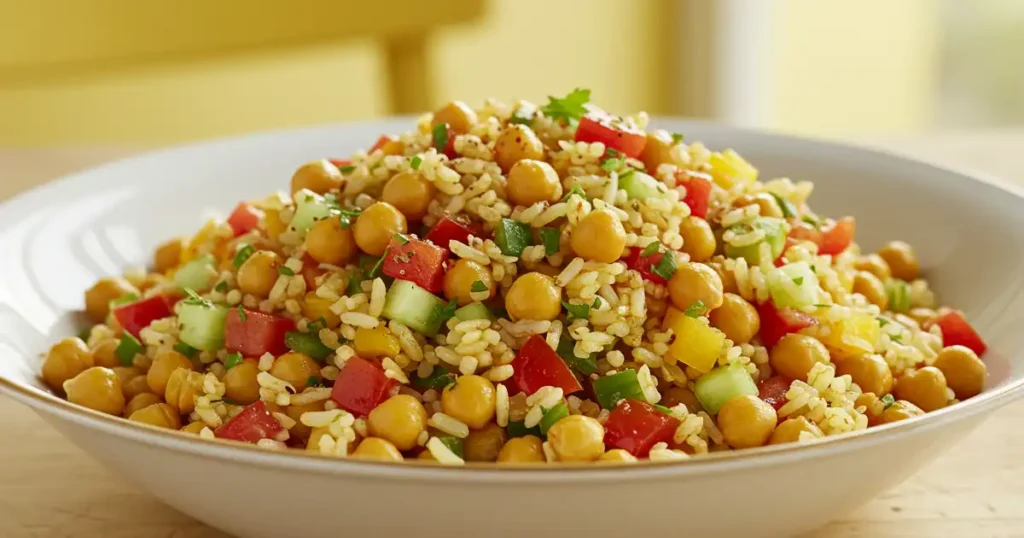
Ingredients:
- 1 cup cooked basmati rice
- ½ cup canned chickpeas, rinsed and drained
- 1 tablespoon olive oil
- ½ cup diced tomatoes
- ¼ cup diced cucumber
- 1 teaspoon lemon juice
- ½ teaspoon cumin
- ½ teaspoon oregano
- 1 tablespoon crumbled feta cheese (optional)
- 1 tablespoon chopped parsley
Instructions:
- Heat olive oil in a pan over medium heat.
- Add chickpeas and sauté for 2 minutes.
- Stir in tomatoes, cucumber, lemon juice, cumin, and oregano.
- Add the cooked basmati rice and mix well.
- Remove from heat and top with feta cheese and chopped parsley.
- Serve warm or at room temperature.
These five healthy fried rice recipes are not only delicious but also nutrient-dense, making them perfect for anyone looking to enjoy a flavorful meal without compromising on health. Whether you prefer quinoa, cauliflower, brown rice, egg whites, or chickpeas, there’s a healthy fried rice recipe for everyone.
FAQs
What’s the secret to fried rice?
The secret to great fried rice lies in a few key techniques:
- Day-old rice : Using leftover, dried-out rice ensures it doesn’t clump together.
- High heat : Cooking at high heat quickly sears the ingredients for maximum flavor.
- Minimal stirring : Allowing the rice to sit briefly on the hot pan creates crispy bits (a.k.a. “charred” or “toasted” rice).
- Balance of ingredients : A mix of aromatics (garlic, ginger), proteins (chicken, shrimp, tofu), vegetables, and seasonings.
What gives Chinese fried rice its flavor?
Chinese fried rice gets its distinctive flavor from:
- Soy sauce : Adds umami and saltiness.
- Oyster sauce (optional): Enhances richness and depth.
- Garlic and ginger : Infuse aromatic notes.
- Scallions : Provide freshness and mild onion flavor.
- Eggs : Add creaminess and protein.
- Vegetables : Ingredients like peas, carrots, and bell peppers contribute sweetness and texture.
What oil is used in fried rice?
Traditionally, vegetable oil or sesame oil is used in fried rice:
- Vegetable oil : Neutral-flavored and ideal for high-heat cooking.
- Sesame oil : Adds a rich, nutty aroma but is usually added sparingly at the end for flavor.
Some recipes may also use pork lard for extra richness, though this is less common today.
Do Chinese restaurants use butter in fried rice?
While traditional Chinese fried rice does not typically include butter, some restaurants—especially Westernized ones—may add a small amount of butter for extra richness and shine. This is more common in American-Chinese cuisine than authentic Chinese cooking
Why does Chinese restaurant fried rice taste so good?
Chinese restaurant fried rice tastes amazing because of:
- Fresh ingredients : High-quality proteins, vegetables, and aromatics.
- Proper technique : Day-old rice, high heat, and minimal stirring create perfect texture.
- Seasoning balance : The right ratio of soy sauce, oyster sauce, and other seasonings enhances flavor without overpowering.
- Crispy edges : Restaurants often cook in large woks over intense heat, producing flavorful, slightly charred rice.
What is fried rice syndrome?
Fried rice syndrome refers to food poisoning caused by Bacillus cereus , a bacteria that can grow in cooked rice left at room temperature for too long. Symptoms include nausea, vomiting, and diarrhea. To avoid this, store leftover rice properly in the refrigerator and reheat it thoroughly before using it in fried rice
Why add mayo to fried rice?
Adding mayo to fried rice creates a creamy, luxurious texture while enhancing the overall flavor. This technique is popular in Japanese-style fried rice (called chahan ) and works especially well with lighter sauces. Mayo helps bind the ingredients and adds richness without making the dish heavy.
Why is my fried rice so crispy?
Your fried rice might be crispy due to:
- High heat : Cooking at high temperatures causes the rice to develop golden, crunchy edges.
- Dry rice : Using day-old rice ensures moisture has evaporated, promoting crispiness.
- Minimal liquid : Avoiding excess sauce or water allows the rice to toast rather than steam.
- Wok hei : The “breath of the wok,” or the smoky flavor and texture achieved through proper wok cooking, contributes to the crispness.
If you prefer softer rice, reduce cooking time or lower the heat slightly.
Craving a delicious, nutritious fried rice dish? You’re in luck! This healthy fried rice recipe is perfect for enjoying Asian cuisine without straying from your diet. It uses fresh, wholesome ingredients and smart cooking techniques. This way, you can make a fried rice dish that’s both tasty and healthy.
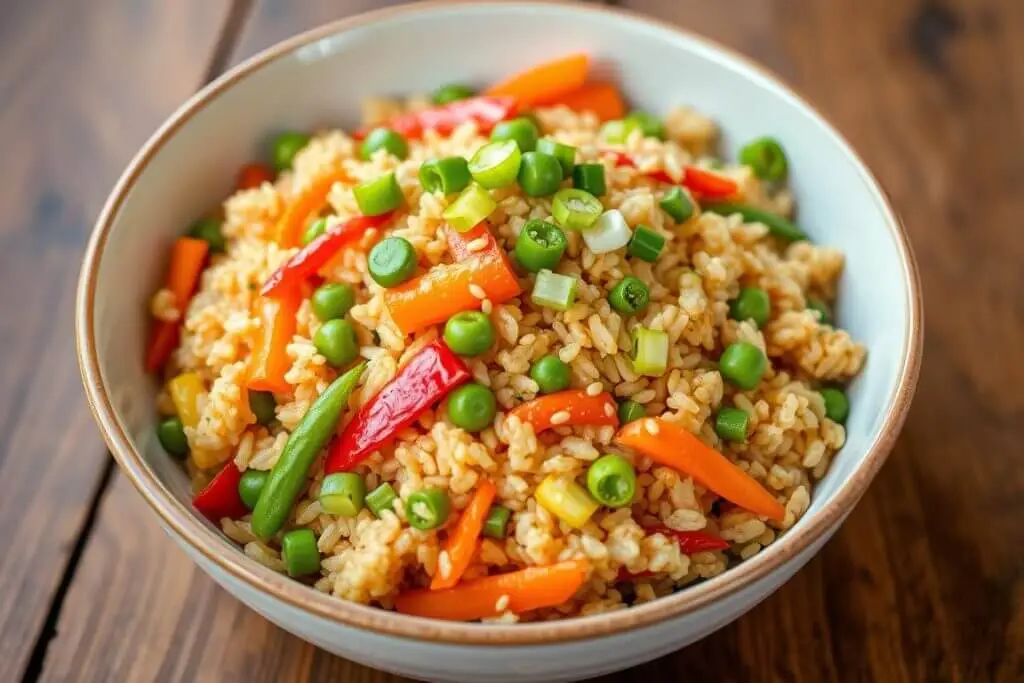
Fried rice is a classic comfort food, but traditional versions can be high in calories, fat, and sodium. Our healthy version swaps out the usual suspects for leaner proteins, a variety of fresh vegetables, and lighter seasonings. The result is a flavorful, satisfying meal that won’t derail your healthy eating goals.
Key Takeaways
- Healthy fried rice is a nutritious alternative to traditional takeout fried rice
- Using fresh, wholesome ingredients and smart cooking techniques can create a delicious and good-for-you fried rice dish
- Fried rice can be a comforting, satisfying meal when made with a lighter touch
- This recipe features lean proteins, a variety of fresh vegetables, and a balanced seasoning profile
- Enjoy the flavors of Asian cuisine while keeping your diet on track with this healthy fried rice recipe
Introduction to Healthy Fried Rice
Fried rice is a favorite in Chinese food and rice dishes. But, the old way can be too rich in calories, fat, and salt. Yet, making a healthier version is easy and still super tasty!
Benefits of Making Healthier Versions
Choosing a healthier fried rice means you get to enjoy its taste without the guilt. Here’s why:
- Less calories and fat
- More nutrients from veggies
- It fits your diet better
Traditional vs. Healthy Variations
The big change is in what you use and how you cook it. Old-school fried rice uses lots of fat, white rice, and thick sauces. But, the new version uses lean meats, brown or cauliflower rice, and less oil and seasonings.
“Fried rice doesn’t have to be unhealthy. With a few simple tweaks, you can create a nutritious and delicious meal that’s good for you too.”
Knowing these differences lets you make fried rice that’s both tasty and healthy. It’s a win-win for your taste buds and your body.
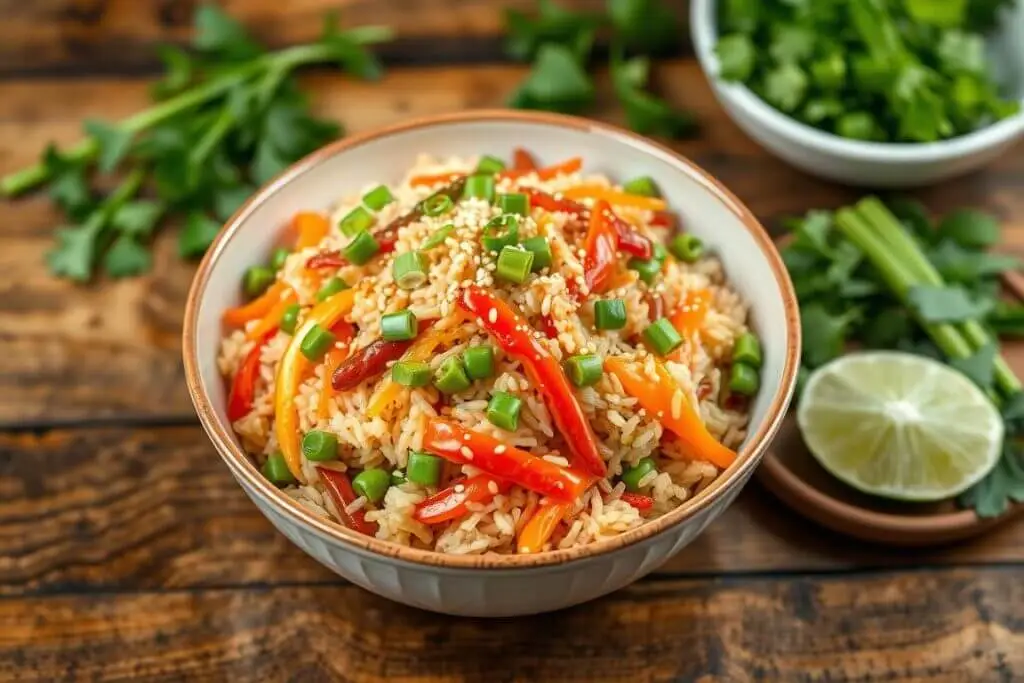
Essential Ingredients for Nutritious Fried Rice
Making a tasty and healthy fried rice starts with the right ingredients. Choose brown rice instead of white rice for a better option. Brown rice has more fiber, minerals, and complex carbs, keeping you full.
Protein is key for a balanced fried rice. Use lean protein sources like grilled chicken, shrimp, or tofu. They add nutrients without too much fat or calories.
- Grilled chicken breasts: A lean, high-protein option that adds flavor and texture.
- Shrimp: A versatile seafood choice that cooks quickly and pairs well with the other ingredients.
- Tofu: A plant-based protein that absorbs the flavors of the dish and provides a meatless alternative.
Don’t forget to add fresh vegetables to your fried rice recipe. Carrots, peas, bell peppers, and scallions add color, crunch, and important vitamins, minerals, and fiber.
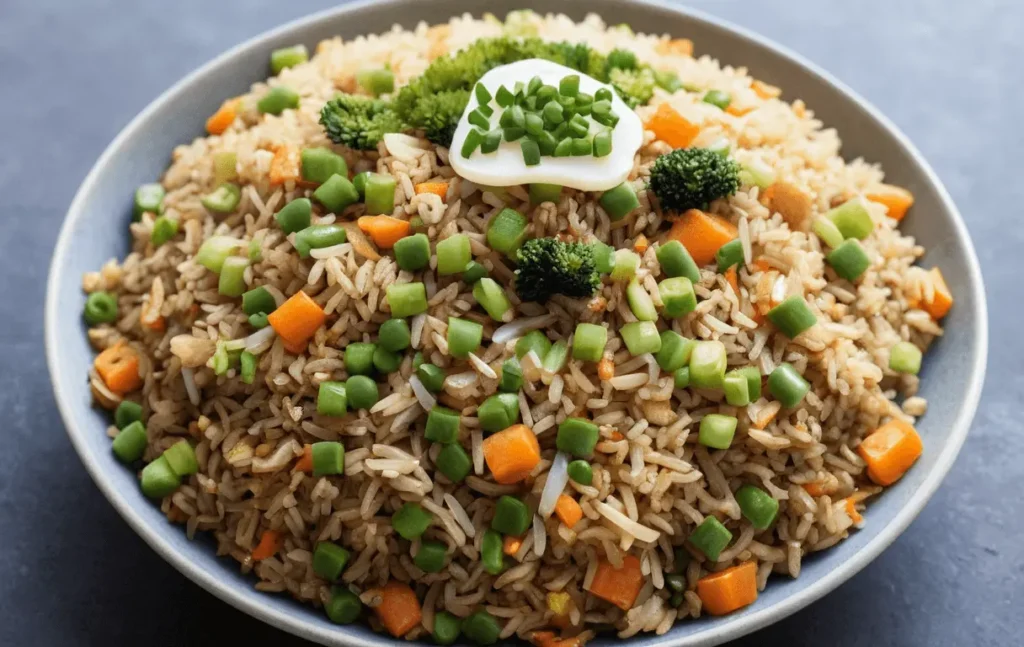
“Embracing a variety of nutrient-dense ingredients is the key to creating a truly nourishing fried rice dish.”
By focusing on whole grains, lean proteins, and colorful veggies, you can make a fried rice that’s both tasty and healthy.
Kitchen Equipment You’ll Need
To make a tasty and healthy fried rice, you’ll need some basic kitchen tools. A wok or large non-stick skillet is crucial for stir-frying. This pan spreads heat evenly and cooks quickly, which is key for the right fried rice texture.
Must-Have Cooking Tools
- Wok or large non-stick skillet
- Wooden or silicone spatula for stirring and tossing
- Sharp knife for dicing vegetables
- Cutting board
- Measuring cups and spoons
Optional but Helpful Accessories
While not essential, some extra kitchen gadgets can help. A rice cooker ensures your rice is perfectly fluffy. A vegetable chopper or mandoline slicer can also speed up chopping your veggies.
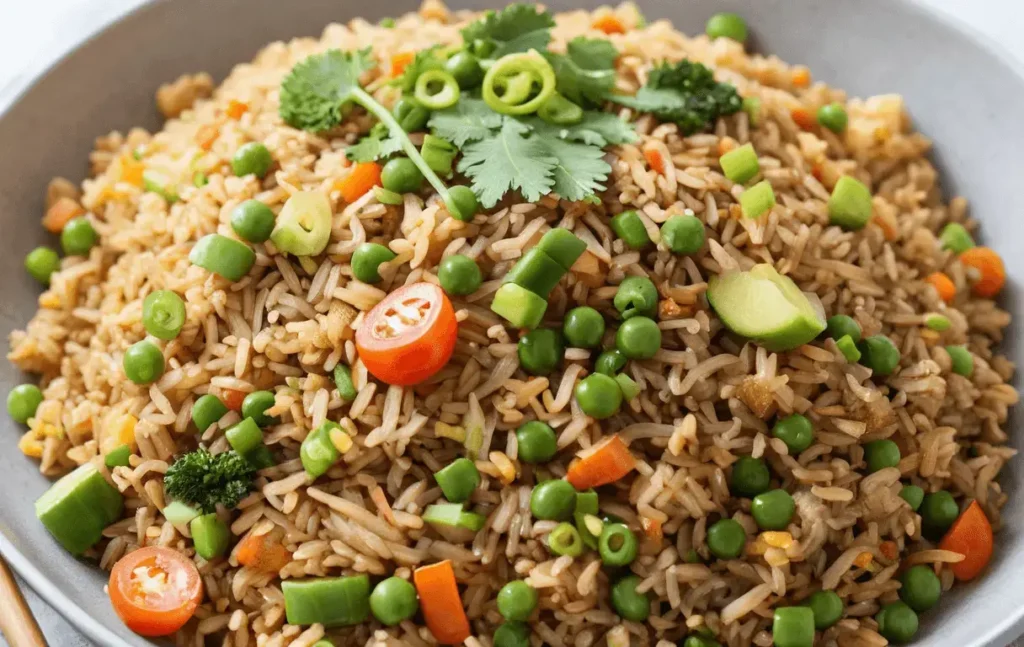
Having the right tools is key to a great fried rice dish. With the right equipment, you’ll make a meal that everyone will love.
Preparing Your Rice the Right Way
To make perfect healthy fried rice, start with the right rice preparation. Brown rice is a better choice than white rice but needs more care.
Rinse the brown rice under cool water until the water is clear. This removes extra starch, preventing stickiness. Then, use a 1:2 rice-to-water ratio and boil it in a saucepan. After boiling, lower the heat, cover, and simmer for 30-40 minutes. The rice should be tender and all liquid absorbed.
- Fluff the cooked rice with a fork and spread it out to cool completely. This is key for the right texture in your fried rice.
- Once cool, handle the rice gently to avoid clumps. Fold it with your hands or a spatula to keep grains separate.
By using these brown rice cooking techniques, you’ll have a great base for your healthy fried rice. Each bite will be fluffy, separate, and full of nutrients.
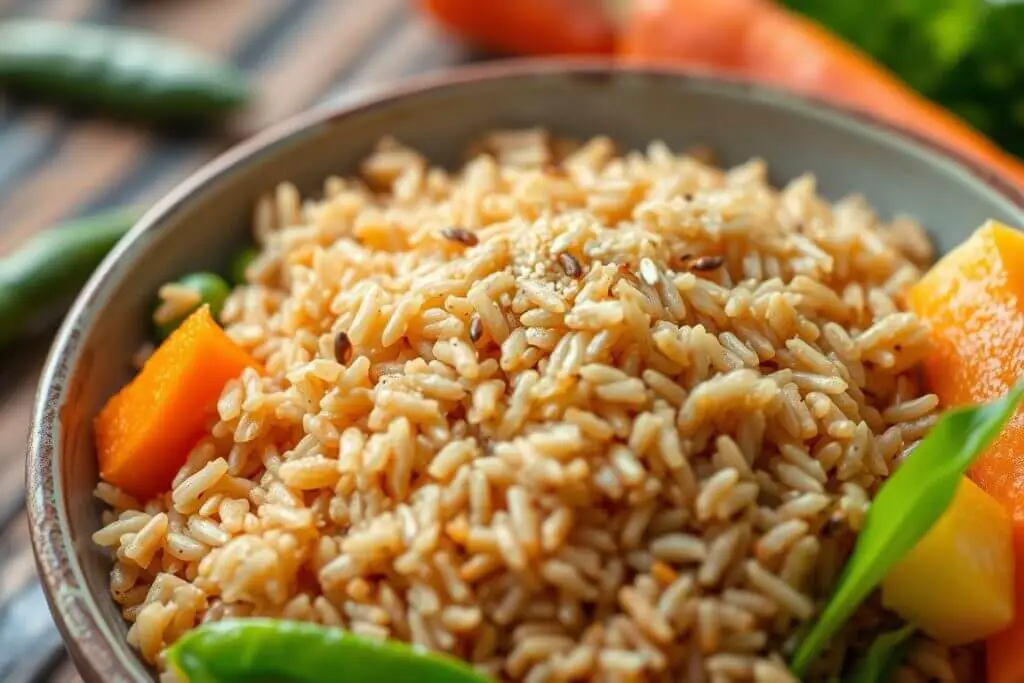
| Cooking Method | Time | Texture |
|---|---|---|
| Boiling | 30-40 minutes | Tender, slightly chewy |
| Steaming | 20-30 minutes | Fluffy, delicate |
| Absorption | 45-60 minutes | Toothsome, nutty |
Mastering rice preparation techniques will help you make a delicious and nutritious fried rice dish.
Choosing the Best Protein Options
Choosing the right protein is key to a healthy fried rice dish. You can pick from lean meats or plant-based options. Each choice affects the dish’s health and taste.
Lean Meat Selections
Lean meats like chicken and turkey are great for fried rice recipe. They’re low in fat and packed with nutrients. Make sure to cook them well and add tasty seasonings.
Plant-Based Alternatives
For a plant-based twist, try tofu or tempeh. Tofu soaks up flavors well, while tempeh adds a meaty texture. Season and cook them right to match your fried rice’s flavors.
Choosing the right protein, like chicken, tofu, or others, makes your fried rice both tasty and healthy.
Fresh Vegetables to Include
Creating a healthy fried rice dish means adding fresh, colorful veggies. These veggies add vibrant colors and essential nutrients to your meal.
Begin with a mix of veggies like carrots, bell peppers, snow peas, and broccoli. These add crunch and flavor, plus important nutrients.
Adding leafy greens like spinach, kale, or bok choy boosts flavor and nutrition. They’re full of folate, fiber, and vitamins.
Make sure to prep your veggies right. Cut them into small pieces and blanch or sauté them before adding to fried rice. This keeps them colorful and tender.
| Vegetable | Nutritional Benefits | Preparation Tips |
|---|---|---|
| Carrots | Rich in beta-carotene, fiber, and vitamin C | Peel and dice into small cubes |
| Bell Peppers | High in vitamin C, vitamin A, and antioxidants | Slice into thin strips or dice |
| Spinach | Packed with folate, iron, and vitamin K | Chop or tear into bite-sized pieces |
| Broccoli | Excellent source of fiber, vitamin C, and vitamin K | Cut into small florets |
By mixing different fresh veggies into your fried rice, you make a dish that’s tasty and full of nutrients.
Healthy Cooking Oils and Seasonings
Choosing the right cooking oil and seasonings is key to a tasty and healthy fried rice. Opt for oils that add flavor and health benefits.
Best Oil Options
Use olive oil or coconut oil for cooking. Olive oil has good fats and antioxidants. Coconut oil has MCTs that may help with weight management. Both oils add unique flavors to your fried rice.
Flavorful Seasoning Combinations
Try different low-sodium seasonings to add depth to your fried rice. Use fresh herbs like garlic, ginger, and scallions. Add sesame oil, rice vinegar, and crushed red pepper flakes for extra flavor.
| Oil | Health Benefits |
|---|---|
| Olive Oil | Rich in monounsaturated fats and antioxidants |
| Coconut Oil | Contains medium-chain triglycerides (MCTs) that may boost metabolism |
With these oils and seasonings, your fried rice will be tasty and nutritious. Try different flavors to find what you like best.
Step-by-Step Fried Rice Instructions
Making delicious, healthy fried rice recipe at home is easier than you think. Just follow a few simple steps to create a dish that rivals the best stir-fries. Let’s go through the steps to help you make perfect homemade fried rice.
First, make sure your wok or large skillet is hot and ready. A high cooking temperature is key for that wok-seared flavor. Once it’s hot, add a tablespoon of healthy oil like avocado or sesame oil.
- Start by sautéing your chosen protein, like lean chicken, shrimp, or tofu. Stir-fry until it’s cooked through and slightly browned.
- Then, add your diced veggies to the pan. Stir-fry for a few minutes until they’re crisp-tender.
- Now, add your cooked rice to the pan. Fold it gently into the veggie and protein mix, without breaking the grains.
- Drizzle in low-sodium soy sauce or liquid aminos, and add your favorite spices and herbs like garlic powder and ginger.
- Keep stirring and tossing the fried rice. This helps the flavors mix and the rice to heat evenly.
- Finally, add a couple of eggs to the pan. Stir them in quickly to make the fried rice cohesive and flavorful.
The secret to great homemade fried rice recipe is quick work, high heat, and constant stirring. With practice, you’ll make delicious, healthy fried rice in no time!
| Technique | Tip |
|---|---|
| Wok or Skillet Temperature | Keep it blazing hot for best results |
| Ingredient Order | Protein first, then veggies, rice, and finally eggs |
| Stirring Frequency | Constant, rapid motion to prevent sticking and overcooking |
“The secret to the perfect fried rice is all in the technique. With a few simple steps, you can elevate a humble dish into a restaurant-worthy meal.”
Tips for Perfect Texture and Taste
Getting the right texture and taste in homemade fried rice recipe is all about a few key techniques. Avoid mistakes like overcrowding the pan, using old rice, or too much seasoning. This will help you get results as good as a restaurant.
Common Mistakes to Avoid
One big mistake is not letting the rice fry well before adding other ingredients. This can make the rice mushy. Also, using very fresh or moist rice can make it sticky. Make sure to use the right amount of oil and let the rice sizzle for a bit.
Professional Chef Secrets
Top chefs use a few tricks to improve their fried rice recipe. They often mix sesame and peanut oils for extra flavor. They also add a lot of seasoning, like white pepper, garlic powder, and soy sauce. Finally, a splash of rice vinegar or Shaoxing wine at the end adds a nice tang.
FAQ
What are the key benefits of making healthier versions of fried rice recipe?
Making healthier fried rice at home means you get a nutritious meal. It has fewer calories and more nutrients. Plus, you can pick the ingredients you like best.
How does traditional fried rice recipe differ from healthier variations?
Traditional fried rice uses white rice and high-calorie oils. It also has more processed ingredients. Healthier versions use brown rice, lean proteins, and fresh veggies.
What are the essential ingredients for a nutritious fried rice dish?
For a healthy fried rice, use brown rice, lean proteins like chicken or tofu, and lots of fresh veggies.
What kitchen equipment is needed to make healthy fried rice recipe at home?
You’ll need a wok or large skillet, a sharp knife, and a spatula or tongs. A rice cooker or vegetable chopper can also be useful.
How do I properly cook and prepare the rice for fried rice recipe?
Use day-old, cooled rice for the best texture. This prevents clumping and makes the rice light and fluffy.
What are the best protein options for healthy fried rice recipe?
Choose lean proteins like chicken, turkey, or shrimp. Tofu and tempeh are great for a meatless option.
What types of fresh vegetables should I include in my healthy fried rice recipe?
Use colorful veggies like carrots, bell peppers, peas, and broccoli. They add flavor, texture, and nutrition.
What are the best healthy cooking oils and seasoning combinations for fried rice recipe?
Use olive oil or coconut oil for cooking. Add low-sodium soy sauce, sesame oil, and aromatic spices for flavor.
What are the key steps to making healthy fried rice recipe at home?
First, cook and cool the rice. Then, sauté the veggies and protein. Finally, mix everything with the right seasoning for a tasty dish.
What are some common mistakes to avoid and professional tips for perfect fried rice recipe?
Avoid using fresh rice, overcrowding the pan, and too much sauce. Stir-fry at high heat, add ingredients in order, and use day-old rice for the best texture.
1 thought on “Fried Rice Recipe”